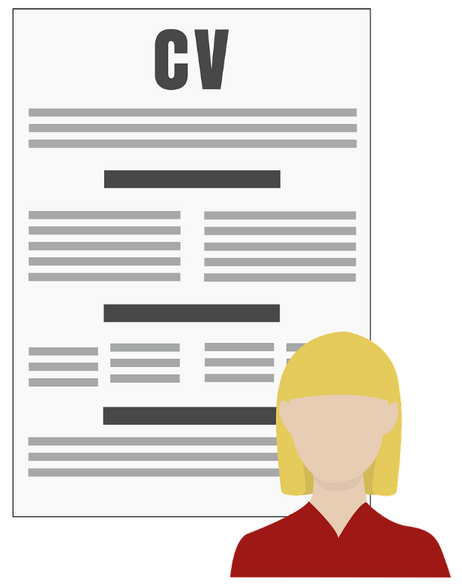How to write a resume?
The first step towards landing in your dream job is to create an awesome resume. There are very few jobs where you get a chance to just walk-in and appear in an interview. Most of the times your resume will be the first impression you will be making on your potential recruiter.
If you get it right you will get tons of interview calls. Mess it up and you may be waiting for an interview call for days, weeks or even months. Not too good for our confidence, is it? In this article we will learn how to write an awesome resume that the HR manager could not ignore.
This is what we are going to cover:
 Table of Contents
Table of Contents- What is a resume?
- Significance of a properly written resume
- Best resume layout
- Types of resume
- Steps to follow while writing a resume
What is a resume?
A resume or curriculum vitae (CV) contains the record of a candidate’s education, skills, work experience, as well as any certificates earned and professional achievements. It may also contain the vision statement of the job aspirant and other details that may strengthen one’s candidature for the job.
Significance of a properly written resume
A resume is the first document that a company will use to assess you. It may decide whether you get an interview call or not. And if you do, then invariably the interviewers will have a copy of your resume when you will walk in for an interview.
So, make sure that you can provide proof and defend whatever you have written in your resume. Even if you are not asked for actual documents, you will definitely be probed on what you have written in the resume. For example, if you have stated that reading novels is your hobby, then you need to be prepared for questions like ‘Who is your favourite author/book?’ etc.
But how to prepare for your interview is not the focus of this article, though both are deeply intertwined. So, now let us see the points we need to keep in mind while writing a resume and thereafter how to structure and actually write a resume. If you do it right, you may even dictate the way your interview goes and what kind of questions are posed to you.
Best resume layout
Before we choose the resume format, and start filling in our resume, you should know about some very essential guidelines. Your resume must look well structured, organized, clean and precise.
According to a study, the average time an HR manager spends on reading and scanning a resume is around 7 seconds! And it’s because he/she may have to go through hundreds and even thousands of resumes for a single post. Believe me, if your resume is cluttered and long, your chances of getting an interview call diminishes exponentially.
For your resume to attract the attention of the recruiter, you need to follow the following best practices related to resume layout:
One-page long resume: You should try limit all your resume content within one page. No HR manger is going to spend much time in reading your resume. The second page may be added in exceptional cases, if you think that some extra information will add significant value.
Proper sub-headings: The content of your resume must be under proper sub-headings. E.g., there should be separate section and heading for contact information, work experience etc. It helps the recruiter to easily scan your resume and locate the information of his interest faster.
Voice: Prefer active voice sentences over passive voice sentences, as active voice sentences sound less-evasive, concise and to the point.
Compare:
A team of 10 software developers was managed by me. (passive voice)
Managed a team of 10 software developers. (active voice)Fresh vocabulary: Try to avoid over-used words and phrases like “responsible for…”. Instead use power words and action words e.g., Managed.
Font: The font should be eye-catching, but also easy on the eyes. For section headings you can use 14-16 points font, while for the body stick to 11-12 points font.
Clean & Uncluttered look: Make sure the content of the resume is not too cluttered. There should be enough white space, between the sections, around the margins etc.
Resume format: Generally, you will need to submit your resume as word file or PDF. But the formatting of word file may get messed up, just because the word document version of the HR manger is different from that of yours. So, if we have a choice, we should prefer the PDF format.
Traditional Vs. Modern layout: You may opt for a traditional or a modern looking layout, depending of the kind of industry and job you are applying for. Traditional layout is basically a simple one column black and white resume. Modern layout is coloured, double column, with various design and infographic elements.
Traditional resume layout: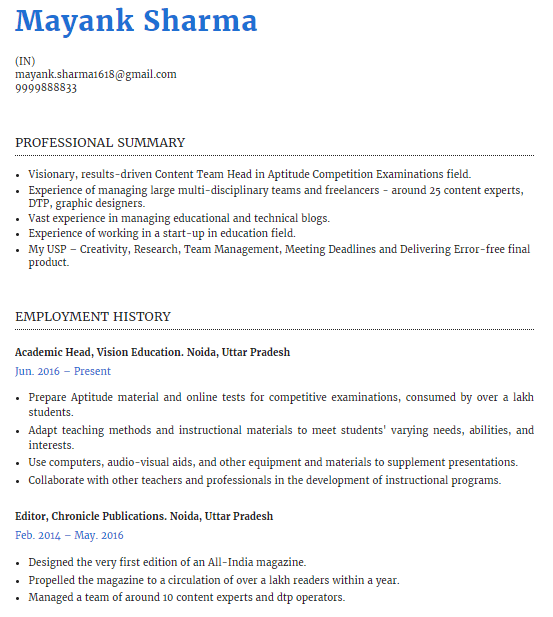
Modern resume layout: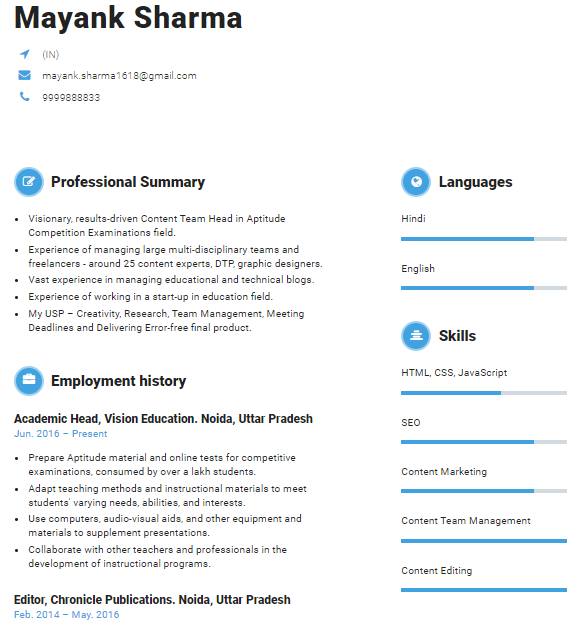
In traditional industries such as, banking, finance we often go for traditional layout. But in jobs such as designer, content manger, digital marketer we should prefer the modern layout.
Choose appropriate resume format (Types of resume)
There are basically three types of resume. The kind of resume that you should go for depends on the job that you are applying for, your experience and the prevalent type in your industry and country.
Let’s have a look at the three types of CV:
Type 1: Reverse chronological work experience
It’s the most prevalent resume type. In it the most recent work experiences and duties are listed first. If you are applying for a job which is closely related to your current job, then this is what you should go for. Afterall you want to highlight the most relevant detail first.
Reverse chronological resume is the most widely used resume type. It is easier to read and scan. In fact, most of the HR managers will expect this kind of a resume from your side, and this is what we are going to focus in this article.
Type 2: Skill based
If you are a fresher or you want a career change, then you would want to highlight your skills first. Work experience, if any, will be listed thereafter. But if you are an experienced person, then using this resume format may install doubts in the minds of the recruiters.
Type 3: Eclectic
Sometimes you want to showcase your skills and experience in multiple fields. This may be the case if you are applying for a senior post e.g., Senior manager, Managing Director etc. For example, if you are applying for the post of Content Head then you may have the skillset of subject knowledge, along with team management skills, digital marketing skills, maybe some HR and technical skills too.
It is a combination of the above two formats (i.e., Reverse chronological and Skill based). It’s not so common a format and the HR manager or the interview panel may find it odd. Definitely not recommended for entry-level job seekers.
Steps to follow while writing a resume (Sections of a resume)
Once you have chosen the kind of resume you want for yourself, it’s time to go into details and write our resume.
The most typical sections in a resume are:
- Resume Summary or Objective
- Relevant Work Experience and Achievements
- Educational details
- Skill-set
- Contact Information
You may or may not add these sections too:
- Hobbies and Interests
- Certificates and Awards
- Co-curricular and Extracurricular activities
- Languages known and your proficiency in them
Let us see the points we need to keep in mind while writing these sections.
Resume Summary or Objective
Of the 6-7 seconds your resume will get, some will definitely be fetched by your resume summary or objective. Afterall it’s placed right at the top of your resume. Basically, it’s the header part of your resume.
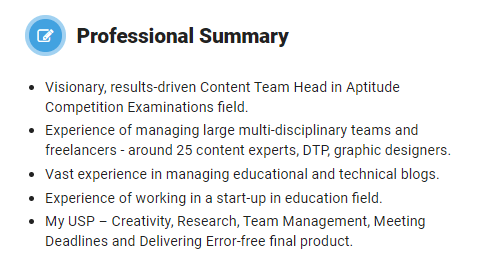
Resume Summary Vs. Resume Objective
If you are an experienced job seeker with relevant skill-set and experience, then you will write your resume summary. You will highlight your most relevant post related experience and skills here.
However, if you are a fresher or looking for career change, then you probably won’t have anything to highlight experience-wise. So, you will have to highlight your objective and skills that are relevant to the job you are applying for.
If you have experience in some related sector, then make sure to highlight the transferable skills. So that the HR manager gets to understand that even if you have not worked in that exact job profile, you do have a relevant job experience.
For example, if you are an Angular developer and applying to a software engineering position requiring you to have a knowledge of React, you may highlight your skills in Vanilla Javascript and Angular. Say you are working as Content Head in an edu-tech company producing video lectures for GMAT, GRE examinations. Then while applying for the post of Content Head in another edu-tech company producing lectures for SAT or CAT you may highlight the subject matter expertise in Aptitude, video creation, editing, infographics creation etc.
You can customize your resume summary according to the post/job you are applying for e.g., mention the name of the company you are sending your resume to. It will provide a nice personal touch to your CV.
Relevant Work Experience and Key Work-related Achievements
This is the most important part of your resume, especially for job aspirants with some experience under their belt. So, it’s placed just under the job summary section in a resume. The HR manager will never miss to look at this part of your resume to find out whether you have relevant work experience or not. However, if you have no or little experience, you may push it down below the skill-set and education section.
You will list down the positions held by you in reverse chronological order i.e., you will start with the current or the most recent post held by you. You need not go back more than 10-15 years. You may use 4-5 bullet points under each position entry, showcasing your responsibilities and achievements.
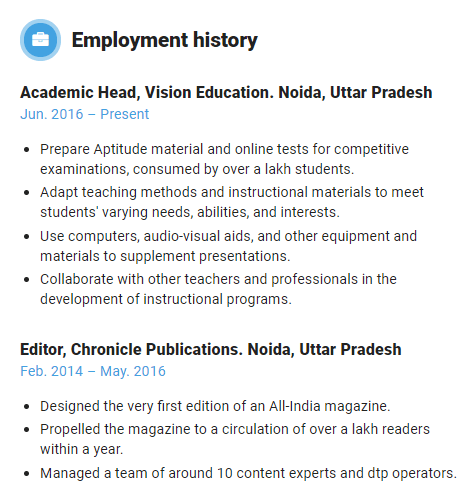
Each entry can be organized as follows:
Job/Position title: This is the name of the position held by you e.g., Software engineer, Academic head, SEO Manager etc. Make it bold.
Timeframe: Write the month and year when you joined the company and when you left. For example, 2018-03 to 2020-08 or March, 2018 to August, 2020. It can be placed just beside the job title, either in brackets or in a separate column. There is no need to provide exact dates. Just month and year will suffice.
Company name: Write the name and maybe the city and state of the company where you held that position. For example, Perot Systems, Noida. You may briefly describe the company if it’s not well known e.g., Perot Systems (American Software MNC).
Key responsibilities: Highlight the tasks that you did, that are relevant to the job you are applying to.
Key achievements: Here you can mention any awards or recognitions you got or any software you made for the company, any extraordinary sales you did etc. Basically, here you want to prove that you were good in whatever you did.
Educational details
Freshers can mention their educational qualifications and skill-set at the top. But if you have enough relevant experience under your belt, you should place these after the work-experience section.
Just like your work experience, you will mention your qualifications in reverse chronological order. Start with your post-graduate and graduate degrees and then mention your XII and X. You should mention the percentage marks / GPA if they are good, else it’s better to skip them as it may prove to be counter-productive. If you are a fresher then you probably will be asked about your marks in the interview anyways.
In case you have had major and minor subjects, then you may mention that too. For example, in case of an MBA degree - Major in Marketing, Minor in Operations.
At the end you may add some relevant awards, honours, co-curricular and extra-curricular activities etc. It will provide a nice finishing touch.
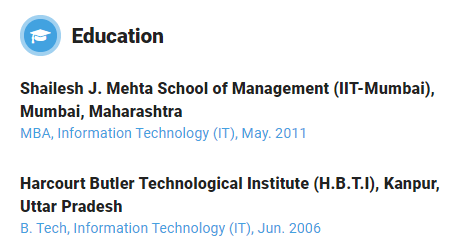
This is the way you can format each of your educational degree:
- Program/Degree name: B. Tech (Information Technology)
- University/College name: Harcourt Butler Technological Institute (H.B.T.I.), Kanpur
- Course Duration: August, 2002 – June, 2006
The following entries are optional:
- GPA/Percentage: 69.1%
- Academic Achievements: 7th position in my branch state-wide (among 115 UPTU colleges), Final year project on Oracle middleware library done in IIT-Kanpur.
Skill-set
Skill section in your resume is as significant as work-experience and education section. Let us first of all have a look at the broad categorization of skills.
Types of Skills
There are two major categories of skills that you can mention:
Hard Skills – These are skills that can be measured, e.g., knowledge of Angular/React coding, English teaching, Social media marketing skills. You often have degrees and certificates to back these claims.
Soft Skills – These are social, communication and decision-making skills. For example, good team player, leadership, management, client handling, etc. These are pretty hard to measure and are often accessed during interview to some extent.
How to list skills on a resume?
You may list 5-6 skills on a resume. That’s generally more than enough. Highlight the skills that are relevant to the job you are applying. It may be a mix of hard and soft skills. It will depend on the kind of job you are applying for.

You need to mention the skill, as well as your proficiency level. There may be 3 or 4 proficiency levels:
- Professional/Expert
- Advanced
- Intermediate
- Beginner
For example, C++ language – Professional, MySQL – Advanced, .NET – Intermediate.
In modern resume format you may use eye-catching infographics to represent it.
Relevant Skills
You should emphasize the skills that are most relevant to the job you are applying for. Remember, a recruiter is only interested in what he wants, not all the variety that you have to offer.
For example, even if you are a very experienced blogger and academic writer, your skills may be misfit if the job is for a technical writer that requires you to have some technical knowledge and experience in writing case studies, e-books, etc.
Have a look at the Job Description (JD) and include atleast 3-4 skills from there in your resume. But while doing so, make sure you do not bluff or misrepresent your skill-set. You will most likely get caught in the interview or during the probation period and it will not augur well for anyone, definitely not your career.
When it comes to relevancy, there’s one more point you need to keep in mind.
How broad or specific you are while enlisting your skills will depend on the kind of job and your experience.
Compare the following two:
Skills enlisted for a job for Search Engine Optimization (SEO) manager may be more specific:
On-page and Off-page SEO – Professional
Technical SEO – Professional
HTML and CSS – Advanced
JavaScript SEO - IntermediateSkills enlisted for a job for Digital Marketing manager may be more general in nature:
Search Engine Optimization (SEO) – Professional
Social Media Marketing (SMM) – Professional
Email Marketing – Advanced
Funnel Creation and Landing page - Intermediate
 Warning
WarningThere’s no point in mentioning skills that you do not have enough knowledge of. It may backfire in the interview, if you are asked questions from that area.
Similarly, kindly do not mention rudimentary skills. For example, if you mention that you are good in using Microsoft office or YouTube, it won’t add any value to your resume.
Placement of Skill section
In a traditional resume you can mention your skills after your educational qualifications. But if you want to highlight both your experience, as well as your skills, you may opt for a more modern two-column resume format. At the top of the first column will be your work experience and at the top of the second column will be your skill-set. So, you get the best of both the worlds.
Contact Information
You need to necessarily provide these in the Contact section:
Full name
Phone Number – Just provide one phone/mobile number. Providing more than one phone number will probably confuse the recruiter, and probably even you in the long run.
Email address – Make sure that your email looks professional, e.g. mayank.sharma@gmail.com and not something like cool.dude@gmail.com
Location – Do provide you location if you are applying for a job wherein you are supposed to go to office. You can just provide your city name. No need to provide your full address. In case of work from home or freelancing opportunities, location does not matter much.
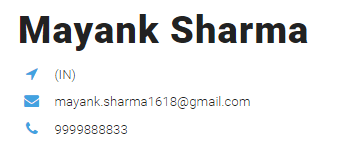
Do make sure you double check all of your contact information. It will be a professional tragedy to miss a good job just because you provided incorrect phone number or email address.
Apart from the essential contact information given above, you can also provide the following information:
Professional title – The name of your position, e.g., Software Engineer, SEO specialist, Academic Head etc.
Linkedln profile – You may give the Linkedln URL in the resume. Nowadays some companies even demand that you provide them one.
Social Media / Website – You may give links of your social media account or page or your blog/website. It will mostly depend on your profile. For example, a content writer or a digital marketer may provide his online portfolio, links to his blog etc. If you are a coder/developer, then probably you can provide link to your Github repositories.
The following pieces of information need not be there in your resume.
Date of birth – Even if the job requires candidates of certain age group, you can mention that in the interview. Mentioning you date will seldom do you any favour. It may infact lead to age-based discrimination in some cases.
Photograph – There’s no need to include your pic/headshot in your resume. How you look should not have any role in you getting selected for a job.
Additional / Optional Information
You may also add some other information in your resume e.g., hobbies and interests, internships, summer projects, volunteer work, certifications and awards, publications, other accomplishments etc.
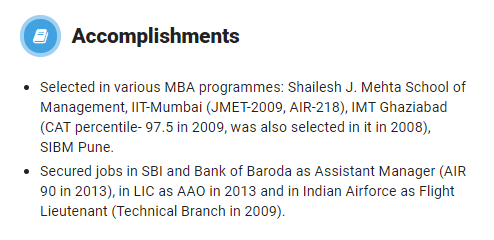
But these sections are optional. You may leave them out of your resume. In some of the interviews you are asked to tell things about you that are not already there in the resume. You may mention these things then.
Winding Up
Remember, resume is just a page long, but it is probably the most important paper of your professional career. So, put in some time and effort in creating a kickass resume for yourself.
You may also supplement your resume with a cover letter. It will be an icing on the cake.
Last but not the least, you should also draft a personalized email to which you will attach your resume (and maybe cover letter too). Nowadays, some companies have their online forms that you need to fill and attach your resume therein. But most of the companies require you to mail them your resume.
So, make sure you include the name of the company or the HR manager in the email. For example, you may greet ‘Dear Natasha’, rather than just ‘Hi’. You may end the email by saying – ‘looking forward to join your team in IBM-Gurgaon’, i.e., subtly giving the HR manager the message that you are not mass emailing your resume to everyone, but instead choosing and applying to selected companies and job positions only.
I have conducted hundreds of interviews myself and recruited many employees. And I have seen many of my colleagues do the same. So, I can tell you by experience, most of the recruiters do not even read the email or the cover letter. The sheer number of applications make it impossible to do so.
But they will definitely go through your resume, atleast just before the interview (if it’s a walk-in) or before deciding whom to call for interview.
If you have made your resume meticulously, keeping in mind all the points mentioned in this article, then rest assured it will fetch you an interview call more often than not. And once you do, you will have an added advantage of a better first impression on the interview panel, even before you enter the room!
